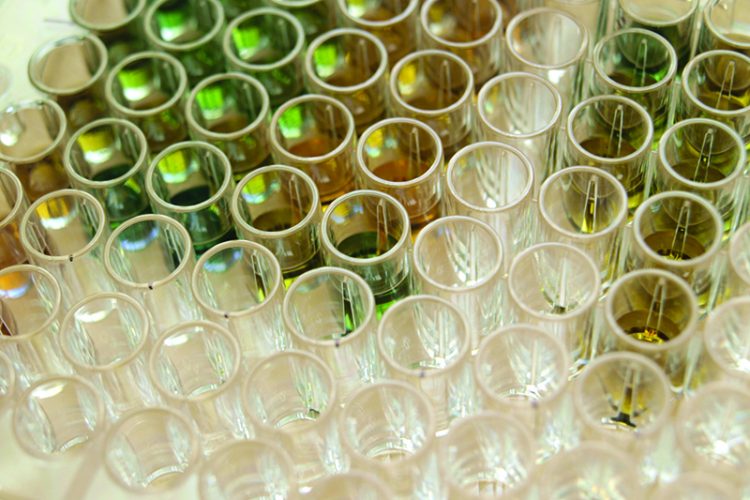The relevance of homogeneous radiometric assays in modern drug discovery
Posted: 14 February 2016 | Gabriele Sorg (Hit Discovery Constance), Horst Flotow (Singapore Screening Centre) | No comments yet
In the past two decades, several alternative, non-radiometric assay formats have been developed for the high-throughput screening (HTS) of target classes such as protein kinases, which were previously screened using radiometric assays. Radiometric screening (and the expertise to perform such HTS) has thus declined in recent years…


Here, we discuss some homogeneous radiometric assay formats that can be run as a high-throughput screen and, we believe, are still highly relevant and useful for drug discovery. We argue that both radiometric and non-radiometric assay formats should be taken into consideration for primary screening in order to design the most relevant assay for the particular target class and the kinds of hits (substrate-competitive, allosteric etc.) required.
Radiometric assays for compound screening
Radiometric assays measure the binding, incorporation or release of radioactive components in an enzymatic or binding reaction. Although non-radiometric alternatives are increasingly used, they are still the mainstay assays for some special applications such as extremely sensitive, rapid, reliable and robust determination of enzyme activities in crude cell lysates1 or amino acid uptake by living cells2. All of the initial radiometric assays were non-homogeneous assays, requiring the separation of substrate and product or bound and free ligand. This separation was usually undertaken by low-throughput methods such as thin-layer chromatography or filtration.
For decades, filter binding assays have been used to assess protein DNA binding, receptor binding and kinase activity, especially under more demanding assay conditions, e.g., using crude tissue homogenates, cell membrane fragments or cellular extracts. Filter-based assays are not susceptible to interference from fluorescent or quenching compounds. Due to the filtration step they are not homogeneous, but still automatable both in 96 well and 384 well plate format and thus somewhat useful for HTS. Filter-based kinase assays are suitable both for phosphorylation of proteins (precipitation onto glass fiber membranes) and for phosphorylation of peptides (capture onto phosphocellulose membranes). Filter-based assays are still the gold standard for some target classes, e.g., for protein kinases3, histone acetyltransferases4 and methyltransferases5.
More recently, a few homogeneous radiometric assay methods have been developed, for example scintillation proximity assays (SPAs) and flashplate. The bead-based SPA is a mix and measure format, fully automatable in 96 well, 384 well and even 1536 well plates, thus rendering many target classes amenable to high-throughput screening. In the past two decades, many homogeneous radiometric methods have been replaced by non-radiometric alternatives in order to avoid the safety requirements and the cost for disposal of radioactive waste. The question arises if radiometric assays, especially the SPA, are still relevant for modern drug discovery.
SPA comparisons
SPA beads are luminescent beads that are spiked with a scintillator or consist of a scintillator. The outside of the bead is modified to specifically capture a radiolabelled assay reaction product. The emission of light from the beads is highly distant dependent, and thus only occurs if the radiolabelled product is directly bound to the bead. Thus, SPA is a versatile homogeneous assay format for many target classes. Examples of SPA assays from the literature include competitive receptor binding assays, protein kinase assays, protein methyltransferase assays6,7,8, protein demethylases9,10, RNA methyltransferases11, DNA methyltransferases12, histone deacetylases13, farnesyl transferases14, geranylgeranyl transferases15, GPCR (35S GTP exchange assay 16), DNA binding proteins17, tRNA synthetases18,19, Stearyl-CoA desaturase20, phosphodiesterases and many more targets. Despite this high flexibility, the use of SPA assays has declined due to the non-radiometric alternative assay formats that are now available for many of the above-mentioned target classes.
For several target classes that do not require antibodies, the development of an SPA may require less time and effort for assay development, with the radiolabelled ligands for various receptor binding assays and generic radiolabelled substrates for many target classes being commercially available.


Interestingly, hits obtained from radiometric screens appear to be generally more readily progressed through the later stages of drug discovery. This may be due to the nature of the radioactive label which replaces a natural part of the ligand respectively substrate instead of adding a bulky fluorophore or other detection group. Thus the binding and kinetic properties of radiolabelled ligands or substrates are comparable to their natural counterparts. An example is a Rab geranylgeranyltransferase assay that revealed different hit profiles when either a fluorescently labelled or a radiolabelled substrate was used. Only the hits from the radiometric assay were active in the cellular secondary assays22. The company Sirtris developed activators of the histone deacetylase SIRT1 using a fluorophore-labelled substrate for HTS. The hits of this screen failed later in drug development, because these compounds were not at all active against the natural substrate 22.
Comparisons of hits obtained with radiometric assays and their non-radiometric alternatives shows that in some cases, there is considerable overlap in the hits found with both radiometric and non-radiometric assays, which has been reported by some researchers23,24, whereas other researchers reported a very limited overlap of hit profiles3,25. Clearly, simply comparing hit lists from radiometric and non-radiometric assays may be comparing apples with oranges; they are designed to pick out different types of inhibitors in many cases (for example, ATP-competitive inhibitors versus peptide substrate competitive inhibitors in the different kinase assay formats).
In addition, highly sensitive spectrophotometric assays such as AlphaScreen may also be very sensitive towards compound interference and give a high false positive rate, where the true hits need to be selected from the false positives using SPA or some other assay6,24. Fluorimetric assays with fluorescently-labelled substrates, antibodies and tracers can be highly susceptible to interference from fluorescent compounds26,27. This interference may be reduced, but not completely eliminated by using higher fluorophore concentrations or red-shifted fluorophores.


An even lower rate of false positives has been reported for a TR-FRET tyrosine kinase assay24, due to the ratiometric readout. Despite this, the authors recommend either SPA for primary screening (or both SPA and TR-FRET) because they had observed 10% false negatives with TR-FRET due to compound interference. Assay formats with coupled enzymes are particularly prone to compound interference due to the inhibition of coupled enzymes (e.g., ATPGlo and ADPGlo for kinases).
To deal with false positive hits, a screening strategy employing secondary assays is usually needed; depending on the format employed in the primary HTS, this may be more or less laborious. In simple enzymatic assays, interfering compounds can easily be sorted out by adding compounds to the stopped reaction. In SPA, which has a lower rate of false positives, this type of counter screen may not be required, thus saving time and cost. The impact is especially high for drug discovery units that use compound pools for primary screening: interference by one compound could mask the real effect of another. A comparison between radiometric and non-radiometric assays for protein kinases and their hit profiles has been provided3, 27.
Conclusions and perspectives
In spite of the availability of many non-radiometric assay formats, homogeneous radiometric assays such as SPA still have some advantages and should be considered as an assay format for primary screening. Radiometric assays are a direct method, where the radioactive label is directly used for detection and therefore, fewer components are required for the assay.
The binding and kinetic properties of radiolabelled ligands and substrates are comparable to the properties of their natural counterparts, in contrast to ligands or substrates labelled with fluorophores or other spectrophotometric detection groups.
The assay development for some of the newer radiometric assay formats such as SPA may be shorter than for non-radiometric methods: antibodies are not needed for most SPA assays and radiolabelled substrates and ligands for several target classes are commercially available. Also, most radiometric assays display a low rate of compound interferences. Lastly, assays like SPA are a broadly accepted homogeneous alternative for radiometric filter binding assays which are still the gold standard for some target classes such as protein kinases and protein-methyltransferases.
It should also be noted that radiometric screening requires highly specialised expertise and equipment to achieve the throughput required, thus, outsourcing to contract research organisations specialising in radioactive screening may be an option for many drug discovery units if they decide to use a this assay format for HTS.
Biographies




HORST FLOTOW is Group Leader, HTS, Head, at the Singapore Screening Centre, A*STAR.
References
- Pavelka S. Development of radiometric assays for quantification of enzyme activities of the key enzymes of thyroid hormones metabolism. Physiol Res 2014; 63 (Suppl. 1):S133-S140
- Cuboni S, Devigny C, Hoogeland B, Strasser A, Pomplun S, Hauger B, Höfner G, Wanner KT, Eder M, Buschauer A, Holsboer F , Hausch F. Loratadine and analogues: Disocvery and preliminary structure –activity relationship of inhibitors of the amino acid transporter B0AT2. J Med Chem 2014; 57: 9473-9479
- Takagi T, Shum D, Parisi M, Santos RE, Radu C, Calder P, Rizvi Z, Frattini MG, Djaballa H. Comb Chem High Throughput Screen 2011; 14(8): 669-687
- Epigenetic technological applications. Edited by Zheng YG. Academic Press 2015, chapter 14, p.296. ISBN 978-0-12-801 080-8
- Epigenetics for drug discovery. Edited by Carey N, Fox D. RSC Drug Discovery 2015, p. 273. ISBN 1849 738 823
- Ibanez G, Shum D, Blum G, Bhinder B, Radu C, Antczak C, Luo M, Djaballah H. A high throughput scintillation proximity imaging assay for protein methyltransferases. Comb Chem High Throughput Screen 2012; 15 (5): 359-371
- Diaz E, Machutta CA, Chen S, Jiang Y, Nixon C, Hofmann G, Key D, Sweitzer S, Patel M, Wu Z, Creasy CL, Kruger RG, LaFrance L, Verma SK, Pappalardi MB, Le B, Van Aller GS, McCabe MT, Tummino PJ, Pope AJ, Thrall SH, Schwartz B, Brandt M. Development and validation of reagents and assays for EZH2 peptide and nucleosome high-throughput screens. J Biomol Screen 2012; 17(10): 1279-1292
- Wu J, Xie N, Feng Y, Zheng YG. Scintillation proximity assay of arginine methylation. J Biomol Screen 2012; 17(2):237-244
- Yu W, Eram MS, Hajian T, Szykowska A, Burgess-Brown N, Vedadi M, Brown PJ. A scintillation proximity assay for histone demethylases. Anal Biochem 2014; 463: 54-60
- Gale M, Yan Q. High-throughput screening to identify inhibitors of lysine demethylases. Epigenomics 2015; 7(1):57-65
- Baker MR, Zarubica T, Wright HT, Rife JP. Scintillation proximity assay for measurement of RNA methylation. Nucleic Acids Res. 2009 Mar; 37(4): e32
- Kilgore JA, Du X, Melito L, Wei S, Wang C, Chin HG, Posner B, Pradhan S, Ready JM, Williams NS. Identification of DNMT1 selective antagonists using a novel scintillation proximity assay. J Biol Chem 2013; 288(27): 19673-19684
- Nare B, Allocco JJ, Kuningas R, Galusca S, Myers RW, Bednarek MA, Schmatz DM. Development of a scintillation proximity assay for histone deacetylase using a biotinylated peptide derived from histone-H4. Anal Biochem 1999; 267: 390-396.
- Zhang FL, Bishop WR. Protein farnesyltransferase assays. Curr Protoc Pharmacol 2001; chapter 3, unit 3.4.
- Stigter EA, Guo Z, Bon RS, Wu Y-W, Choidas A, Wolf A, Menninger S, Waldmann H, Blankenfeldt W, Goody RS. Development of selective, potent RabGGTase inhibitors. J Med Chem 2012; 55(19):8330-8340
- Rodgers G, Hubert C, McKinzie J, Suter T, Statnick M, Emmerson P, Stancato L. Development of displacement binding and GTPgammaS scintillation proximity assays for the identification of antagonists of the µ-opioid receptor. Assay and Drug Dev Technol 2003; 1 (5): 627-636
- Gal S, Cook JR, Howells L. Scintillation proximity assay for DNA binding by human p53. BioTechniques 2006; 41:303-308
- Macarrón R, Mensah L, Cid C, Carranza C, Benson N, Pope AJ, Diez E. A homogeneous method to measure aminoacyl-tTNA synthetase aminoacylation activity using scintillation proximity assay technology. Anal Biochem 2000; 284(2):183-190
- Hu Y, Guerrero E, Keniry M, Manrrique J, Bullard JM. Identification of chemical compounds that inhibit the function of glutamyl-tRNA synthetase from Pseudomonas aeruginosa. J Biomol Screen 2015; 20 (9): 1160-1170
- Tawa P, Falgueyret J-P, Guiral S, Isabel E, Powell AD, Zuck P, Skorey K. High throughput scintillation proximity assay for stearoyl-CoA desaturase -1. J Biomol Screen 2011; 16:506-517
- Heise CE, Sullivan SK, Crowe PD. Scintillation proximity assay as a high-throughput method to identify slowly dissociating nonpeptide ligand binding to the GnRH receptor. J Biomol Screen 2007; 12(2): 235-239
- Eickhoff J. GIT-Labor (2015) Hochdurchsatz-Screening. .http://www.git-labor.de/forschung/pharma-drug-discovery/hochdurchsatz-screening. Retrieved on 22 Feb 2016
- Park YW, Cummings RT, Wu L, Zheng S, Cameron PM, Woods A, Zaller DM, Marcy AI, Hermes JD. Homogeneous proximity tyrosine kinase assays: scintillation proximity assay versus homogeneous time-resolved fluorescence. Anal Biochem 1999; 269: 94-104
- Ahsen O, Schmidt A, Klotz M, Parczyk K. Assay Concordance between SPA and TR-FRET in high throughput screening. J Biomol Screen 11(6), 2006
- Sills MA, Weiss D, Pham Q, Schweitzer R, Wu X, Wu JJ. Comparison of assay technologies for a tyrosine kinase assay generates different results in high throughput screening. J Biomol Screen 2002; 7(3): 191-214
- Singh P, Lillywhite B, Bannaghan C, Broad P. Using IMAP technology to identify kinase inhibitors: comparison with a substrate depletion approach and analysis of the nature of false positives. Comb Chem High Throuput Screen 2005; 8(4): 319-325
- Ma H, Deacon S, Horiuchi K. The challenge of selecting protein kinase assays for lead discovery optimization. Expert Opin Drug Discov 2008; 3(6): 607-621
Related topics
Assays, Drug Discovery, High-Throughput Screening (HTS), Kinases, Protein, Radiometric assays, Screening








